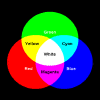Additive
Color: the RGB Color System
If we are working on a computer, the colors we see on the
screen are created with light using the additive color method. Additive color
mixing begins with black and ends with white, meaning that as more color is
added, the result is lighter and tends to white.
The RGB color system is an example the light primaries and creates color with
light. Percentages of red, green, & blue light are used to generate color on
a computer screen. The basic colors of light are red, green and blue.


The most common example of additive color synthesis is the color television
screen, (or RGB monitor), which is a mosaic of red, green, and blue dots; at
normal viewing distances the eye does not distinguish the dots, but blends or
adds their stimulus effects to obtain a composite color effect.
![[RGB COLOR DOTS]](images/Color/Lectur3.gif)
The
principals of additive color synthesis are as follows
 (a) Equal stimulus
proportions of two primary colors create a secondary color.
(a) Equal stimulus
proportions of two primary colors create a secondary color.

 (b)
Equal stimulus proportions of all three primaries create white:
(b)
Equal stimulus proportions of all three primaries create white:







![[RGB COLOR DOTS]](images/Color/Lectur3.gif)




